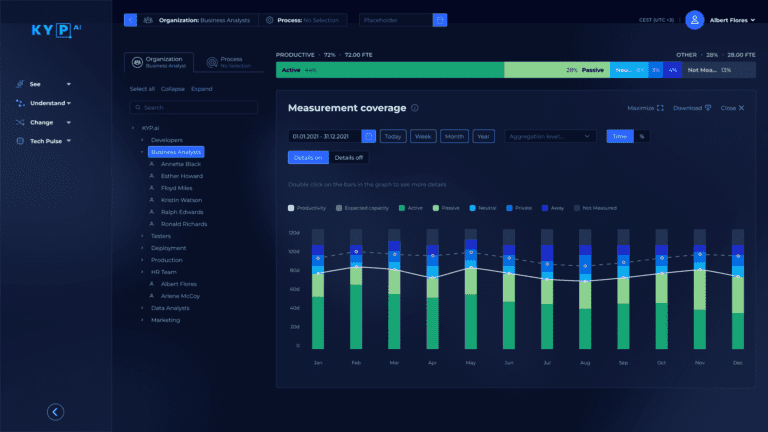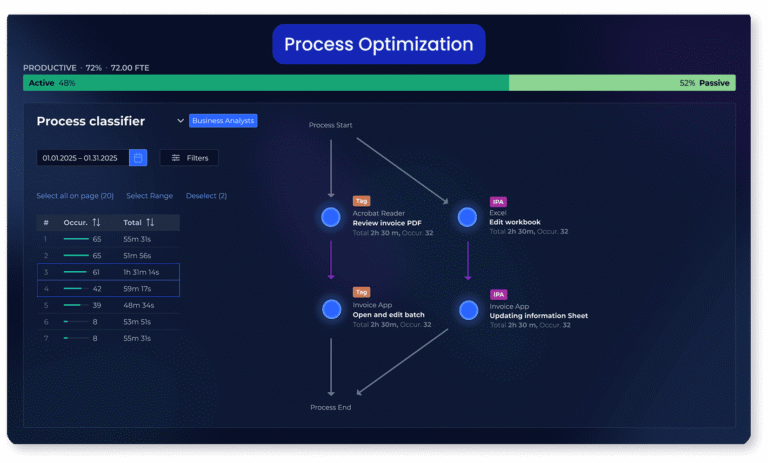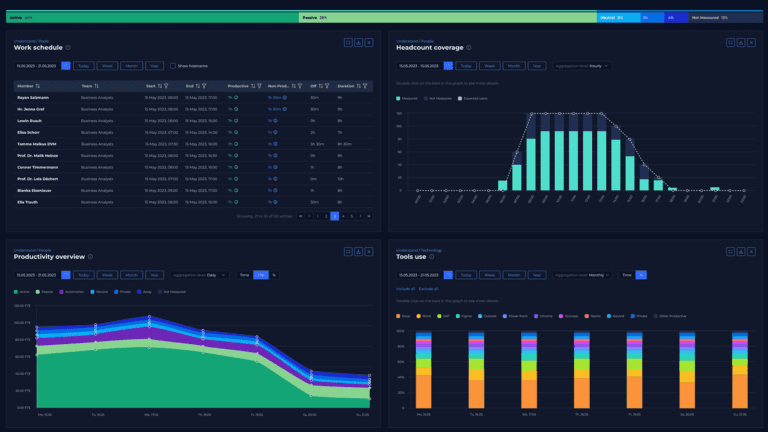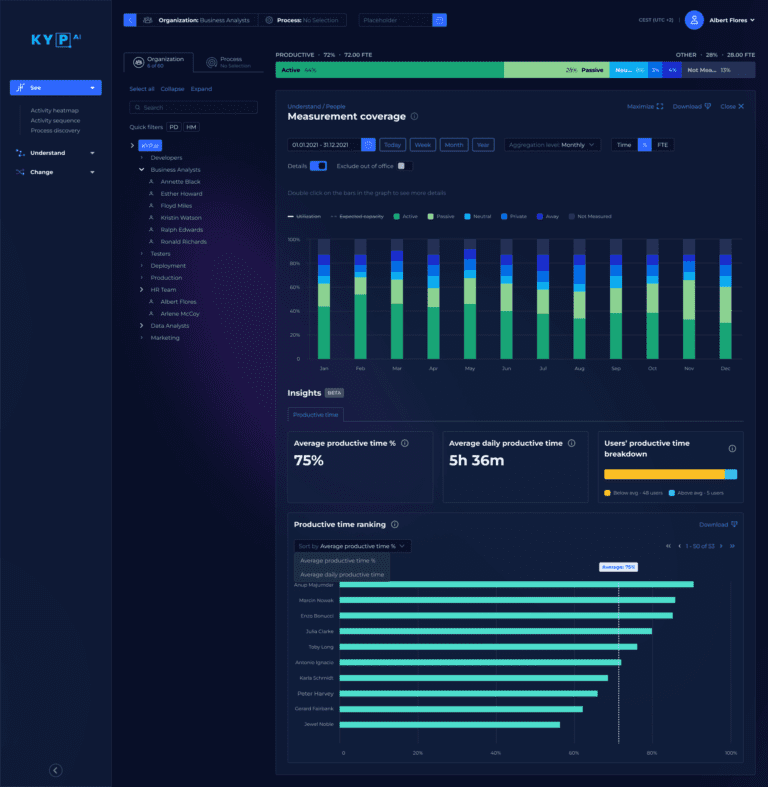Process intelligence is one of the fastest growing categories for enterprise software. This report explains why and helps you find the best-fit solution for your needs.
Why it matters:
- 51% of large enterprises now use process intelligence solutions to gain visibility into business operations, with another 23% planning adoption.
- Many organizations report 15-25% decreases in operating costs, with other tangible benefits like 20-30% reductions in process times.
- This year 59% of process intelligence solution users expect to see cost reductions, with most companies reporting positive ROI within 6-12 months.
Process intelligence in brief
Process intelligence is a technology that automatically captures and analyzes how work flows through an organization’s different IT systems or business operations. It works like an X-ray for businesses by providing a transparent, data-driven view of internal operations, revealing exactly what happens in a process instead of relying on assumptions.
Two foundational technologies power this capability:
- Process mining analyzes event logs in enterprise resource planning (ERP) systems to map workflows across departments and applications. It answers questions like: How long does it really take to close a customer issue? Where do purchase orders stall? When was an invoice sent?
- Task mining captures what happens at the workstation level. It shows how your people actually interact with software and different business applications. It reveals the manual work hiding between systems and identifies which repetitive tasks you should automate first.
EY expects the process intelligence market to experience a 572% increase between 2023 and 2028, reaching a market size of over $12 billion annually.
Top 5 process intelligence software solutions
If you’re in the market for a process intelligence solution, you’re likely to come across five leading software providers:
1. KYP.ai
KYP.ai goes beyond traditional process and task mining to provide ROI-focused process intelligence that connects discovery to execution. The Productivity 360 platform emphasizes speed to insight, integration with automation workflows and unlocking potential of agentic AI.
2. Celonis
As the category creator for process mining tools, Celonis leads in market maturity and can handle complex, enterprise-wide process analysis of event log data. Strong in orchestration and governance use cases.
3. SAP Signavio
SAP Signavio integrates process intelligence with SAP’s broader business process management suite. A natural fit for SAP-centric organizations.
4. IBM Process Mining
In 2021 IBM acquired the process mining solution MyInvenio. Today, IBM Process Mining combines process intelligence with IBM’s enterprise AI and automation portfolio. Emphasizes integration with robotic process automation.
5. UiPath Process Intelligence
UiPath’s process intelligence solution embeds process discovery within UiPath’s automation platform. Tight coupling between finding automation opportunities and building automated workflows.
Your selection depends on your strategic priorities: comprehensive best-of-breed capabilities, tight integration with existing enterprise software, or embedded functionality within your automation platform.
Key benefits of process intelligence
Process intelligence is not just about capturing process steps and workflows. It blends traditional business intelligence methods with prescriptive insights to show how you can optimize your organization’s performance.
Here are key benefits you should expect from any process intelligence solution.
Transparency into how work gets done
Process intelligence enables data-driven decision making by showing the as-is state of processes based on how actual work gets done. Compared to traditional interview-based methods of process discovery, it is more accurate, less subjective and more cost-efficient to run.
This matters because you can’t fix what you can’t see accurately. Your improvement initiatives fail when built on faulty assumptions about current operations, or you don’t have up-to-date information on how your optimizations are performing. Process intelligence works like a regular cadence of X-rays, showing not just the broken operations, but also the realized business impact of improvement when you take action.
Identify bottlenecks and inefficiencies
Like Peter Drucker once famously said, “you can’t improve what you can’t measure.” Process intelligence points you to specific bottlenecks and inefficiencies that you may not otherwise measure in complex, routine business operations.
This matters because the root cause of many inefficiencies may not be clear to operational excellence consultants viewing operations from a bird’s eye perspective. With process intelligence you get a detailed data-driven view from the people doing the actual work. You can target improvements where they’ll actually work instead of implementing changes that look good on paper but miss the real problems.
Identify automation opportunities
Many enterprise businesses look to increase the automation of core business processes through different automation technologies including, but not limited to robotic process automation (RPA), and more recently agentic AI. Process intelligence helps you identify and prioritize automation candidates within the tasks and workflows that make the biggest impact on your business performance.
This matters because automation by itself doesn’t drive value, unless it improves how work gets done. Process intelligence shows you the high-volume, rules-based activities where automation delivers measurable returns. More importantly, it reveals which processes need fixing before you automate them. Remember, automating broken processes just makes them fail faster.
Build the case for AI-driven transformation
When you ask for a budget to transform business operations with AI, your CFO may ask reasonable questions: What baseline are you improving from? How will you measure success? What return should we expect?
Recently a study from MIT revealed that 95% of AI pilots in enterprise fail because tools don’t learn from feedback, can’t retain context across sessions, and don’t integrate deeply enough into existing workflows to justify switching costs.
Process intelligence provides the metrics. You establish current performance, predict improvement, track actual results, and demonstrate ROI with data your finance team trusts.
Six stages of a process intelligence process
Whether you utilize process or task mining to capture how work gets done, most process intelligence solutions follow a similar six-step process:
- Data extraction pulls event logs from your core systems or captures user activity data. Every work action leaves a digital trace. Process intelligence follows those traces like a fingerprint.
- Data preparation standardizes information from different sources into a unified format. Your ERP speaks a different language than your CRM, your different teams may use different business applications to perform the same task. This step creates a common vocabulary.
- Process reconstruction uses algorithms to build visual maps of your actual workflows. You see exactly how work moves, branches, and sometimes circles back in ways you never intended.
- Data analysis identifies where time and money leak from your processes. Advanced platforms can predict where problems will emerge and recommend specific fixes proactively.
- Optimization enablement translates insights into action plans and ROI. Process intelligence solutions help you quantify the benefits of automating or streamlining key tasks. You know precisely which changes will deliver the biggest impact.
- Continuous monitoring tracks whether your improvements actually work and spots new issues as your business evolves.
When exploring your options, you may come across process mining solutions that do task mining, or task mining solutions that compliment process mining. Ultimately, your value add is not going to come from how work interactions get captured, but from the insights you gain.
Barriers to adoption (and how to overcome them)
Even organizations that recognize process intelligence’s value often struggle with implementation. Four challenges consistently emerge:
Lack of ownership
Process intelligence spans multiple domains from business process management, automation, IT operations, and enterprise transformation. This can make it complicated to execute. Does the CIO own it because it involves system data? The COO because it’s about operations? The transformation office because it enables change? Without clear ownership, your initiative stalls.
How to overcome: Assign ownership explicitly and give that person authority to act on insights. According to Deloitte, among organizations already using process intelligence successfully, 81% of high-value generators have established centers of excellence, compared to only 66% of low-value generators.
Unclear business case
You may struggle to quantify expected benefits if you lack baseline metrics and expectations. Process intelligence adoption takes time and effort. Don’t start with technology costs. Start with the business problem: How much does slow customer onboarding cost you in lost revenue? What’s the impact of compliance violations? How much capacity would you gain if you eliminated your most time-consuming manual processes in procure-to-pay or invoice-to-cash?
How to overcome: Process intelligence helps you quantify expected gains accurately, which makes the solution’s value clear. According to research by KYP.ai, enterprise organizations typically report 15-25% decreases in operating costs, with other tangible benefits like 20-30% reductions in process times. Consider these benefits, when building your business case.
Pilot projects are poorly scoped
According to Deloitte, the portion of enterprise businesses piloting process mining solutions decreased from 39% in 2021 to 15% in 2025. This trend reflects a concern that pilot projects are not scoped efficiently.
Organizations make two common mistakes: analyzing processes that are already well-understood (wasting effort proving what everyone knows) or tackling their most complex, cross-functional processes first (overwhelming the team and delivering unclear results).
How to overcome: Effective pilots choose processes that are important enough to matter, badly understood enough to generate real insights, and contained enough to show results quickly. They focus on proving the approach works rather than solving your biggest problem immediately.
Lack of executive buy-in
Without sufficient executive support, process intelligence can remain a departmental tool that never scales. This happens when senior leaders don’t understand what process intelligence enables. They may think of it as “just better process mapping.” They may fund the technology but don’t engage with the insights.
How to overcome: If you’re the executive sponsor, your job is to ask hard questions that only process intelligence can answer: Why does this process perform differently across regions? Where is our actual cycle time versus our target? Which customer segments experience the most friction? When you demand answers that require process intelligence to produce, you drive adoption.
How process intelligence compliments other initiatives
Process intelligence doesn’t replace your existing operational excellence frameworks. It makes them work better.
Organizations pursuing operational excellence have always combined multiple methodologies to drive improvement:
- Business process mapping documents how processes should work through workshops and interviews. When you pair this with process intelligence, you see the gap between design and reality. You map the target state, then use process intelligence to measure how far current operations deviate and track progress toward your goal.
- Customer journey mapping traditionally relies on surveys and focus groups to understand customer experience. Process intelligence adds objective data: you see exactly where customers face delays, which channels they’re forced to use, and where experiences vary unexpectedly.
- Capability mapping defines the business capabilities you need to execute strategy. Process intelligence shows you which capabilities your current processes actually support well and which exist more in PowerPoint than in practice.
- Value stream mapping identifies waste in end-to-end processes. Process intelligence makes value stream mapping faster and more accurate by automatically identifying handoffs, wait times, and non-value-adding steps instead of relying on observation and estimation.
- Lean and Six Sigma provide proven frameworks for process improvement. Process intelligence accelerates these methodologies by replacing manual data collection with automated analysis and continuous monitoring with real-time dashboards.
Process intelligence acts as an accelerant, adding objective measurement and continuous visibility to approaches that traditionally relied on periodic assessment and manual data collection. Think of it as the X-ray or MRI machine in the hands of a great doctor.
Fresh process intelligence case studies
KYP.ai has emerged as a leader in delivering rapid, measurable results across diverse industries through its comprehensive Productivity 360 platform. Unlike traditional data mining solutions that take months to implement, KYP.ai provides 360-degree visibility across people, processes, and technology within days and measurable outcomes within 2-4 weeks.
Process intelligence productivity and efficiency gains
The following case studies demonstrate KYP.ai’s ability to deliver significant productivity gains and cost savings across insurance, BPO services, and technology sectors:
- Hollard: 20% productivity increase, 307 hours saved monthly.
- Allied Global: Nearly 20% productivity improvement in sales/customer service, 25% increase in active productive FTE.
- Mindsprint: 15 years of manual analysis replaced by real-time insights across 600+ processes and 1200+ employees.
- Alorica: $2.5M annual savings, 18% productivity increase, 26% automation potential identified.
- Atento: 35% productivity improvements, 25-27% efficiency gains across multiple processes.
How KYP.ai can deliver better ROI
The platform’s advanced GenAI capabilities and conversational AI (KYP.ai Concierge) enable organizations to discover automation opportunities through pattern recognition that goes far beyond traditional rule-based approaches.
By providing prescriptive recommendations rather than just dashboards, KYP.ai helps organizations determine the most suitable automation approach, whether RPA, agentic AI, process elimination, or other solutions.
As an Agentic-AI-ready process intelligence platform, Kyp.ai transforms raw process and organizational context into trusted, executable AI agent scripts – eliminating the guesswork and risk of generic AI models. This guarantees your AI agents act with precision and context awareness, delivering measurable impact from day one.
By anchoring AI agents in live process insights, KYP.ai enables confident, scalable AI automation deployments at enterprise speed – turning AI ambition into dependable reality while safeguarding governance and operational integrity.
In other words, with KYP.ai, hallucination is not just an error – it’s a nonstarter. Trust, transparency, and rigor power your AI-driven transformation.
To discover why KYP.ai is among the top process intelligence solutions ranked by analysts such as Forrester, Everest and Gartner, book a demo today.
Where process intelligence is heading
The market is expanding beyond its original focus on process analysis and automation candidate identification into four strategic areas:
- Process orchestration uses process intelligence to coordinate complex workflows across systems and teams in real-time. You move from analyzing how work happens to actively directing where it should go next.
- Governance, risk, and compliance applications monitor processes continuously to ensure regulatory compliance, manage risk, and maintain quality standards. Instead of sampling and auditing after the fact, you spot violations as they occur.
- AI enablement grounds artificial intelligence agents in actual process data to reduce errors and ensure AI systems operate within established guardrails. As you deploy AI agents to handle customer service, process claims, or manage workflows, process intelligence provides the contextual understanding these systems need to work reliably.
- Business transformation uses process intelligence as the foundation for comprehensive operating model change. Organizations create digital twins of their operations to test changes before implementation and track transformation progress objectively.
- Shift to predictive insights. According to HFSResearch, 50% of enterprise leaders are looking for ways to use process intelligence data more predictively.
This expansion reflects a fundamental shift: process intelligence is moving from an analysis tool to becoming the nervous system for improving operational infrastructure.
The bottom line
Process intelligence has evolved from a niche analysis tool into essential operational infrastructure. With 51% of large enterprises actively using these solutions and 74% adoption or planning adoption, the technology has crossed into mainstream acceptance.
Yet adoption alone doesn’t guarantee results. Success requires clear ownership, well-scoped pilots that prove value quickly, and executive sponsorship that demands data-driven answers to operational questions. Organizations that treat process intelligence as a complement to existing operational excellence frameworks—enhancing rather than replacing Lean, Six Sigma, and value stream mapping—extract the most value.
The technology is also shifting from retrospective analysis toward real-time orchestration, predictive insights, and AI enablement. Process intelligence is becoming the measurement layer that makes other improvement methodologies faster, more accurate, and continuously visible. Organizations that understand this evolution position themselves to move from periodic improvement events to sustained operational excellence powered by continuous, objective process data.
Discover Your Productivity Potential – Book a Demo Today
Book Demo








